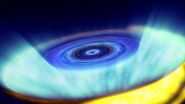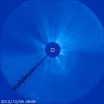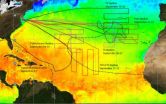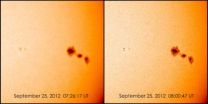(Press-News.org) WASHINGTON -- NASA's Swift satellite recently detected a rising tide of high-energy X-rays from a source toward the center of our Milky Way galaxy. The outburst, produced by a rare X-ray nova, announced the presence of a previously unknown stellar-mass black hole.
"Bright X-ray novae are so rare that they're essentially once-a-mission events and this is the first one Swift has seen," said Neil Gehrels, the mission's principal investigator, at NASA's Goddard Space Flight Center in Greenbelt, Md. "This is really something we've been waiting for."
An X-ray nova is a short-lived X-ray source that appears suddenly, reaches its emission peak in a few days and then fades out over a period of months. The outburst arises when a torrent of stored gas suddenly rushes toward one of the most compact objects known, either a neutron star or a black hole.
The rapidly brightening source triggered Swift's Burst Alert Telescope twice on the morning of Sept. 16, and once again the next day.
Named Swift J1745-26 after the coordinates of its sky position, the nova is located a few degrees from the center of our galaxy toward the constellation Sagittarius. While astronomers do not know its precise distance, they think the object resides about 20,000 to 30,000 light-years away in the galaxy's inner region.
Ground-based observatories detected infrared and radio emissions, but thick clouds of obscuring dust have prevented astronomers from catching Swift J1745-26 in visible light.
The nova peaked in hard X-rays -- energies above 10,000 electron volts, or several thousand times that of visible light -- on Sept. 18, when it reached an intensity equivalent to that of the famous Crab Nebula, a supernova remnant that serves as a calibration target for high-energy observatories and is considered one of the brightest sources beyond the solar system at these energies.
Even as it dimmed at higher energies, the nova brightened in the lower-energy, or softer, emissions detected by Swift's X-ray Telescope, a behavior typical of X-ray novae. By Wednesday, Swift J1745-26 was 30 times brighter in soft X-rays than when it was discovered and it continued to brighten.
"The pattern we're seeing is observed in X-ray novae where the central object is a black hole. Once the X-rays fade away, we hope to measure its mass and confirm its black hole status," said Boris Sbarufatti, an astrophysicist at Brera Observatory in Milan, Italy, who currently is working with other Swift team members at Penn State in University Park, Pa.
The black hole must be a member of a low-mass X-ray binary (LMXB) system, which includes a normal, sun-like star. A stream of gas flows from the normal star and enters into a storage disk around the black hole. In most LMXBs, the gas in the disk spirals inward, heats up as it heads toward the black hole, and produces a steady stream of X-rays.
But under certain conditions, stable flow within the disk depends on the rate of matter flowing into it from the companion star. At certain rates, the disk fails to maintain a steady internal flow and instead flips between two dramatically different conditions -- a cooler, less ionized state where gas simply collects in the outer portion of the disk like water behind a dam, and a hotter, more ionized state that sends a tidal wave of gas surging toward the center.
"Each outburst clears out the inner disk, and with little or no matter falling toward the black hole, the system ceases to be a bright source of X-rays," said John Cannizzo, a Goddard astrophysicist. "Decades later, after enough gas has accumulated in the outer disk, it switches again to its hot state and sends a deluge of gas toward the black hole, resulting in a new X-ray outburst."
This phenomenon, called the thermal-viscous limit cycle, helps astronomers explain transient outbursts across a wide range of systems, from protoplanetary disks around young stars, to dwarf novae -- where the central object is a white dwarf star -- and even bright emission from supermassive black holes in the hearts of distant galaxies.
Swift, launched in November 2004, is managed by Goddard Space Flight Center. It is operated in collaboration with Penn State, the Los Alamos National Laboratory in New Mexico and Orbital Sciences Corp. in Dulles, Va., with international collaborators in the United Kingdom and Italy and including contributions from Germany and Japan.
INFORMATION:
For images related to this discovery and more information about Swift, visit:
http://go.nasa.gov/QLlkCH
NASA's Swift satellite discovers a new black hole in our galaxy
2012-10-06
ELSE PRESS RELEASES FROM THIS DATE:
Sun spits out a coronal mass ejection
2012-10-06
At 11:24 p.m. EDT on Oct. 4, 2012, the sun unleashed a coronal mass ejection (CME). Not to be confused with a solar flare, which is a burst of light and radiation, CMEs are a phenomenon that can send solar particles into space and can reach Earth one to three days later. Experimental NASA research models show the CME to be traveling at about 400 miles per second.
When Earth-directed, CMEs can affect electronic systems in satellites and on Earth. CMEs of this speed, however, have not generally caused major effects in the past. Further updates will be provided if needed.INFORMATION:
NOAA's ...
NASA's HS3 mission thoroughly investigates long-lived Hurricane Nadine
2012-10-06
NASA's Hurricane and Severe Storm Sentinel or HS3 scientists had a fascinating tropical cyclone to study in long-lived Hurricane Nadine. NASA's Global Hawk aircraft has investigated Nadine five times during the storm's lifetime.
NASA's Global Hawk also circled around the eastern side of Hurricane Leslie when it initially flew from NASA's Dryden Research Flight Center, Edwards Air Force Base, Calif. to the HS3 base at NASA's Wallops Flight Facility, Wallops Island, Va. on Sept. 6-7, 2012.
Nadine has been a great tropical cyclone to study because it has lived so long ...
Getting NASA's SDO into focus
2012-10-06
From Sept. 6 to Sept. 29, 2012, NASA's Solar Dynamic Observatory (SDO) moved into its semi-annual eclipse season, a time when Earth blocks the telescope's view of the sun for a period of time each day. Scientists choose orbits for solar telescopes to minimize eclipses as much as possible, but they are a fact of life -– one that comes with a period of fuzzy imagery directly after the eclipse.
The Helioseismic and Magnetic Imager (HMI) on SDO observes the sun through a glass window. The window can change shape in response to temperature changes, and does so dramatically ...
NASA sees very strong wind shear battering Tropical Storm Gaemi
2012-10-06
It is easy to see the effect of the strong northeasterly wind shear battering Tropical Storm Gaemi in satellite imagery from NASA. Visible imagery on Oct. 5 shows a large oval-shaped area of showers and thunderstorms associated with the storm, southwest of the exposed center of circulation.
NASA's Aqua satellite passed over Tropical Storm Gaemi as it was approaching Vietnam on Oct. 5, 2012 at 0550 UTC (1:50 a.m. EDT). A true-color image of the storm was captured by the Moderate Resolution Imaging Spectroradiometer (MODIS) instrument and shows bulk of showers and thunderstorms ...
BUSM study investigates genetic variants' role in increasing Parkinson's disease risk
2012-10-06
(Boston) – Boston University School of Medicine (BUSM) investigators have led the first genome-wide evaluation of genetic variants associated with Parkinson's disease (PD). The study, which is published online in PLOS ONE, points to the involvement of specific genes and alterations in their expression as influencing the risk for developing PD.
Jeanne Latourelle, DSc, assistant professor of neurology at BUSM, served as the study's lead author and Richard H. Myers, PhD, professor of neurology at BUSM, served as the study's principal investigator and senior author.
A ...
The Largest Electric Power Expo of China Unveils in Beijing Smart Grid Technology in the Spotlight
2012-10-06
With the rapid development of industrialization and urbanization in China, the demand for electricity continues to grow, according to a report by State Grid Corporation of China. Exploring and utilizing renewable energy, enhancing energy efficiency are significant to the energy supply, energy structure adjustment and energy-saving in China. Being the No. 1 Electric Power Expo in China, The 14th International Exhibition on Electric Power Equipment and Technology, The 7th International Exhibition on Electrical Equipment and 2012 International Exhibition on Electric Power ...
Puja Sapra, Director, Oncology Research Unit at Pfizer Will Give a Featured Presentation at the 5th ImmunoTherapeutics & ImmunoMonitoring Conference (Jan 31 - Feb 1, 2013 in San Diego)
2012-10-06
Puja Sapra, Director, Oncology Research Unit at Pfizer Will Give a Featured Presentation on "Design Considerations For Development of an Optimal Antibody-Drug Conjugate" at the 5th ImmunoTherapeutics & ImmunoMonitoring Conference (Jan 31 - Feb 1, 2013 in San Diego)
Antibody-drug conjugates (ADCs) represent a promising therapeutic modality for the clinical management of cancer. Dr. Puja Sapra will use case studies to elaborate on the multifaceted optimization required to yield a viable clinical candidate ADC. ADCs employing different mechanism of action ...
New Start-Up bMighty2 Helps Small Businesses Spread Their Message Via the Internet
2012-10-06
Powered by a team with years of experience in marketing, technology, and design, bMighty2 is a new digital marketing agency that promises to help small businesses find success online.
The start-up will help small businesses leverage the Internet and Web 2.0 for their marketing needs using a multi-channel approach. Services to be offered by bMighty2 include website development, local search engine optimization, email marketing, social media marketing, and directory link building.
"bMighty2 was built from the ground up to help small businesses understand and ...
Local Non-Profit Announces FUBU Co-Founder as National Spokesperson.
2012-10-06
We are pleased to announce One Community, One Voice, One Vision National Spokesperson, Mr. Keith Perrin, Jr. The vision of OCOVOV aligns perfectly with his passion to give back and support our communities. Mr. Perrin is an accomplished, well known entrepreneur who successfully introduced FUBU clothing apparel brand to the world with his three business partners. He says, "Sometimes all it takes is
ONE opportunity to make a difference. Giving back to others is the main focus of One Community One Voice One Vision and that is why I am honored to be the national spokesperson ...
E1/Ethernet Tester with Advanced Heat Radiation System
2012-10-06
Toronto, Canada - GAO Comm (www.GAOComm.com) has announced the release of its E1/Ethernet tester which conducts 50b/s to 2048 b/s error testing and tests over multiple V ports. This tester is a comprehensive test tool for E1, V port, Gigabit Ethernet link maintenance and failure diagnosis.
This small and convenient E1/Ethernet tester, model A0050004, features easy operation, a rugged dustproof design and advanced heat radiation system. It has PPPoE, FTP download, terminal emulation and Web browsing functions. It also provides a large number of Ethernet diagnostic tools ...




